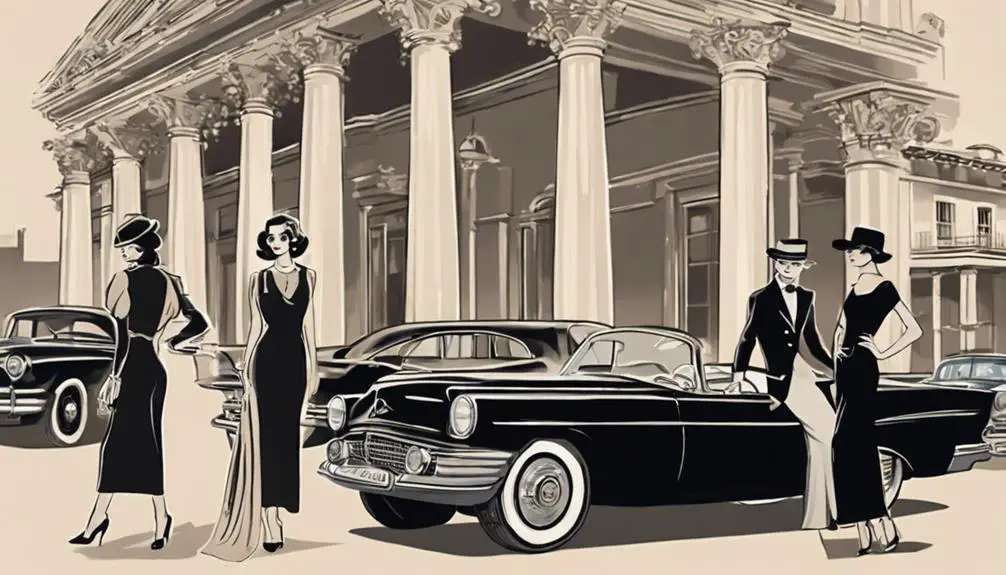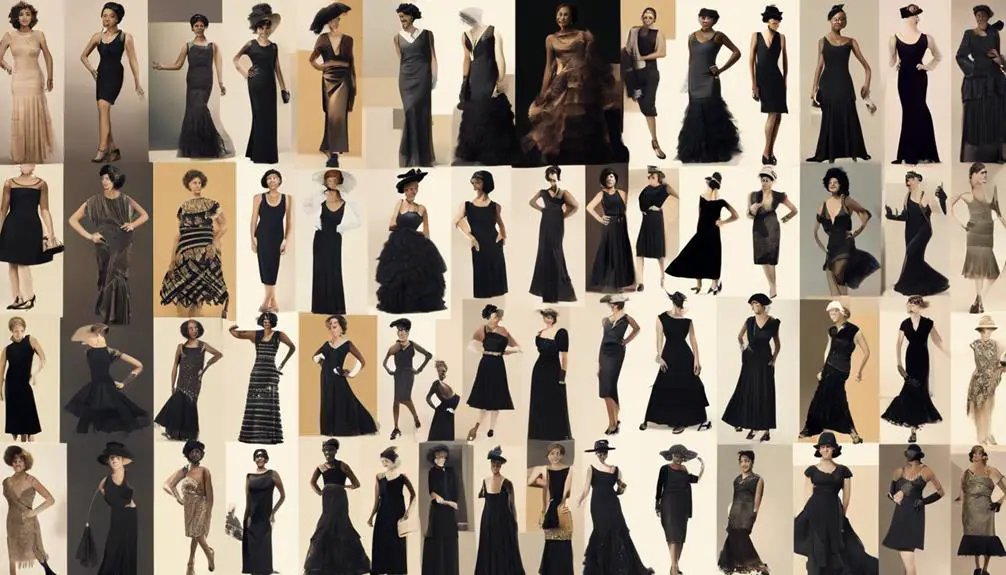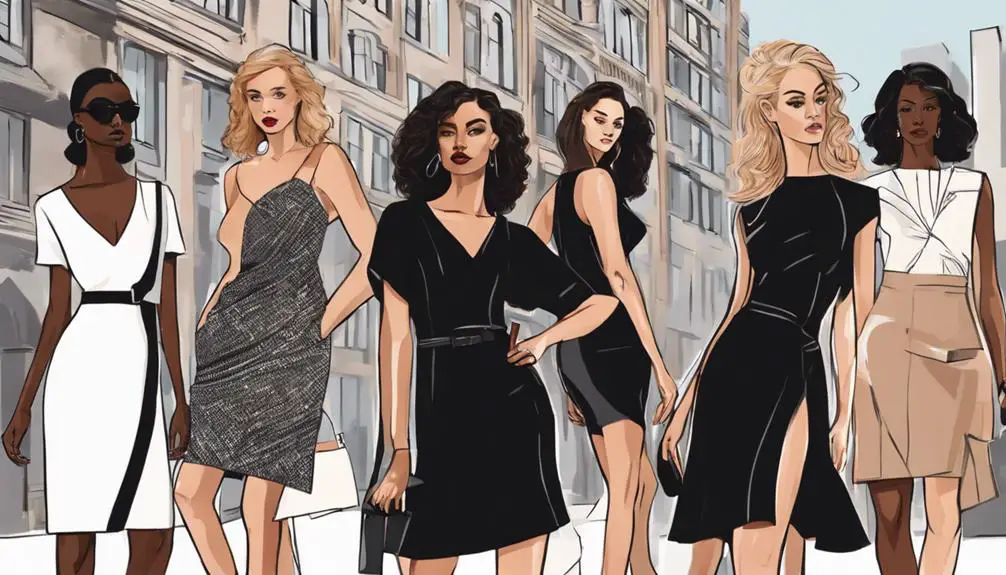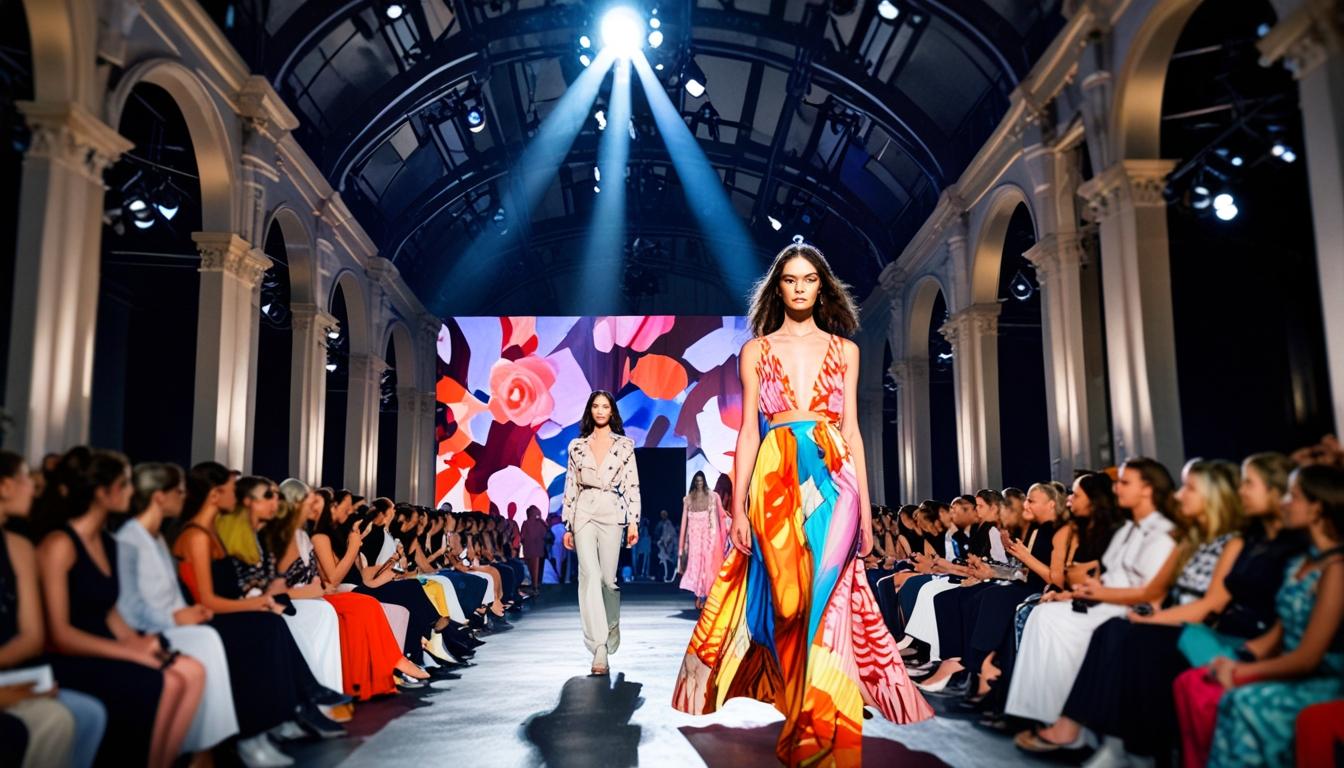When you think about the Little Black Dress, it's easy to overlook its profound history and cultural significance. Originally popularized by Coco Chanel in the 1920s, this garment shifted perceptions of black fabric from a symbol of mourning to one of elegance and empowerment. As you explore its evolution, consider how this simple dress became a canvas for self-expression and rebellion against fashion norms. What does its journey reveal about societal changes and women's independence over the decades? The answers might surprise you.
Historical Context of the LBD

Emerging from the shadows of mourning attire, the Little Black Dress (LBD) transformed into a symbol of elegance and empowerment by the time Coco Chanel popularized it in 1926. Before this, black was mainly seen as a color for mourning, especially during the Victorian era, where widows wore it for what felt like forever. But then, Coco Chanel stepped in and flipped the script! She introduced the LBD as an accessible fashion piece, dubbed "Chanel's Ford," making it available to women of all classes. This shift not only changed perceptions of black clothing but also opened doors for innovative tailoring techniques, allowing women to customize their dresses and embrace their individuality through fashion, as seen in how to tailor vintage garments.
Fast forward to the Great Depression, and the LBD became even more relevant. In tough economic times, women needed stylish yet affordable options, and guess what? The elegant black dress fit the bill perfectly. It wasn't just a dress; it became a symbol of modern femininity, breaking free from the restrictive styles of the past.
And who could forget Audrey Hepburn? Her iconic role in "Breakfast at Tiffany's" solidified the LBD as a timeless staple in every woman's wardrobe. When you think of the Little Black Dress, you're not just thinking of a piece of clothing; you're embracing a legacy of empowerment, elegance, and style. So, whether you're dressing up for a fancy dinner or just want to feel fabulous, the LBD has got your back! Isn't it amazing how a simple dress can carry so much history and meaning?
Iconic Designs and Features
Since its inception, the Little Black Dress (LBD) has been celebrated for its iconic designs and features that blend simplicity with elegance. Think about it: the LBD is your go-to piece for almost any occasion! Its simple yet elegant silhouette makes it versatile enough to shine at a casual brunch or a fancy gala. You can style it in countless ways, so you're never stuck wearing the same look twice. Curiously, much like how vintage Ralph Lauren pieces are identifiable through their unique characteristics, the LBD also showcases distinct styles that reflect the era in which it was designed specific characteristics of vintage items.
Coco Chanel's original design back in 1926, affectionately called "Chanel's Ford," was all about minimalist lines that appealed to women of all social classes. How cool is that? Fast forward to the 1950s, and we see Dior's New Look reshaping our beloved LBD into a garment that highlighted feminine curves, adding allure to the mix. Then came the 1960s, bringing shorter hemlines and bold, experimental designs. Each decade added its own twist!
Today, modern interpretations of the LBD continue to evolve. Designers play with different fabrics, patterns, and styles, ensuring the LBD remains relevant in the world of fashion. From sustainable materials to inclusive sizing, there's an LBD out there for everyone. So, whether you're dressing it up with pearls or keeping it casual with sneakers, you can embrace the little black dress's timeless charm. Isn't it wonderful how one dress can adapt to your style while keeping its iconic status?
Cultural Significance Over Time

The Little Black Dress (LBD) has transcended mere fashion, becoming a powerful symbol of modern femininity and empowerment. Since its introduction by Chanel in 1926, this timeless piece has represented more than just style; it embodies independence and strength. Can you picture a world where women were just starting to break free from traditional roles? That's when the LBD emerged, allowing women to express their sophistication without sacrificing comfort or financial means—like owning a "Chanel's Ford" in fashion!
Over the decades, cultural icons like Audrey Hepburn and Marilyn Monroe have rocked the LBD on screen, further cementing its status as a staple in the fashion world. These ladies didn't just wear it; they transformed it into a symbol of versatility. Whether it's a fancy event or a casual outing, the little black dress adapts to any situation.
And let's not forget its connection to movements like feminism and body positivity! It stands proudly as a representation of women's choices, reminding us that style should reflect who we are, not who society says we should be.
Today, the LBD continues to be a must-have in wardrobes around the globe. It's more than just a dress; it's a statement of empowerment and a nod to a rich history of fashion. So, when you slip into that little black dress, know you're not just following a trend—you're joining a legacy!
Notable Figures and Their Influence
While many fashion pieces come and go, the influence of notable figures on the Little Black Dress (LBD) has solidified its place in style history. Coco Chanel kicked things off in 1926, introducing the LBD to the world. Vogue called it "Chanel's Ford," highlighting how affordable and accessible it was. Can you imagine a time when women didn't have this essential piece in their wardrobe?
Fast forward to 1961, and you've got Audrey Hepburn strutting her stuff in that iconic black Givenchy dress in "Breakfast at Tiffany's." It wasn't just a dress; it was a statement of elegance and sophistication. That dress sold for a jaw-dropping £410,000 at auction in 2006!
Then there's Marilyn Monroe, who rocked the LBD in "Gentlemen Prefer Blondes" in 1953. She showed everyone just how glamorous Hollywood fashion could be. And let's not forget Édith Piaf, whose powerful voice shined in her simple black sheath dress, proving that sometimes less is more.
In the late 1990s, Victoria Beckham, known as Posh Spice, revived the LBD, showcasing its versatility for modern fashion. Isn't it amazing how these figures shaped the LBD into the timeless piece we adore today? Their influence is undeniable, turning the Little Black Dress into a staple for every woman's closet. So, what's stopping you from adding your own twist to this iconic fashion classic?
Modern Interpretations and Trends

Modern fashion has seen a fresh wave of creativity surrounding the Little Black Dress (LBD), as designers push boundaries with innovative materials and unique patterns. You might notice that modern designers are experimenting more than ever, making the LBD a canvas for contemporary aesthetics. From bold cuts to playful textures, there's a version out there for everyone!
One of the coolest trends is how social media is changing the game. It's showcasing body positivity and inclusivity, allowing all shapes and sizes to rock their own stylish LBD. You don't have to fit into a mold; instead, you can embrace your individuality. Plus, with the rise of sustainable fashion, many brands are focusing on ethically produced LBDs, aligning with what you care about—our planet!
Custom designs are also gaining popularity. Why settle for off-the-rack when you can tailor your LBD to reflect your unique style? Mixing prints, adding a belt, or opting for a custom length can make all the difference. And let's not forget about fashion shows! They often highlight the adaptable appeal of the LBD, showing how it fits into different cultural contexts and fashion movements.
Frequently Asked Questions
What Does the Little Black Dress Symbolize?
The little black dress symbolizes elegance and simplicity, merging fashion and feminism. Its versatility reflects cultural and social shifts, offering iconic, timeless style for evening or casual wear, empowering your individuality and expression while balancing luxury and affordability.
What Is the History Behind the Little Black Dress?
The little black dress illustrates fashion evolution, showcasing cultural significance through iconic designers and celebrity influence. Its fabric choices and color psychology adapt to seasonal trends, offering modern interpretations and accessorizing tips with global variations for every occasion.
What Is the Origin of the Black Dress?
Like a chameleon, the black dress adapts through fashion evolution, reflecting cultural significance. Its design variations and fabric choices, influenced by Hollywood and celebrity endorsements, create iconic moments that shape modern adaptations and social statements in color psychology.
Why Do You Think the Little Black Dress Became so Important in the 1920S?
You'll find the little black dress embodies a fashion revolution, reflecting societal changes and women empowerment. Its design innovation and iconic moments, fueled by celebrity influence and economic factors, promote personal expression and timeless elegance.




Altcoin news